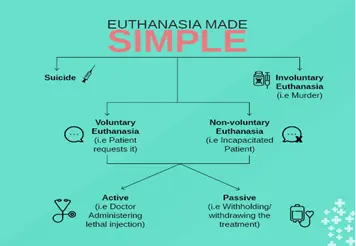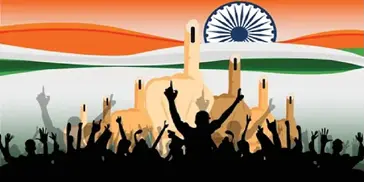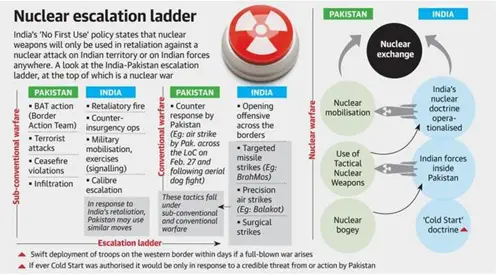Monday, 26th August 2024
India To Be Free of Naxalism By 2026
Why in the news?
- Union Home Minister Amit Shah announced that the final and ruthless battle against Maoists is imminent, aiming to eradicate Left-Wing Extremism (LWE) in India by March 2026.
- After a meeting in Raipur, he emphasised the need for a strong strategy to decisively combat LWE, calling it the biggest challenge to India's democracy.
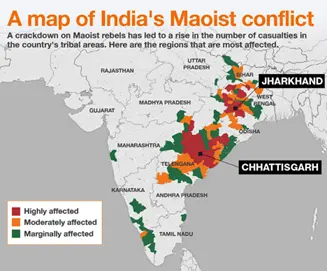
What is Naxalism ?
- Origin:
- Naxalbari Movement: Naxalism originated in the village of Naxalbari, West Bengal, as a rebellion against landlords following a violent land dispute.
- Spread: The movement expanded to less developed regions in Eastern India, particularly in states like Chhattisgarh, Odisha, and Andhra Pradesh.
- Terminology: Left-Wing Extremists (LWE) are globally known as Maoists and are referred to as Naxalites in India.
- Objective:
- Ideological Goal: Naxalites aim to overthrow the Indian government through armed revolution to establish a communist state based on Maoist principles.
- Perception of the State: They view the state as oppressive, exploitative, and serving the ruling elite, advocating for armed struggle to address socio-economic grievances.
- Modus Operandi:
- Tactics: Naxalite groups employ guerrilla warfare, attacks on security forces, extortion, intimidation, and propaganda to further their objectives.
- Strategic Approach: Their strategy involves armed insurgency, mass mobilisation, and forming strategic alliances.
- Targets: Government institutions, infrastructure, economic interests, and perceived collaborators are common targets.
- Parallel Governance: In areas under their control, Naxalites operate parallel governance structures, providing basic services and dispensing justice.
- Status of Left-Wing Extremism (LWE) in India:
- Reduction in Violence: As of 2022, the number of violent incidents and deaths in Naxal-affected areas is at a four-decade low.
- Statistical Decline:
- Violent incidents decreased by 77% in 2022 compared to the peak in 2010. The number of LWE-affected districts was reduced from 90 to 45.
- Deaths of security personnel and civilians declined by 90%, from 1,005 in 2010 to 98 in 2022.
- States Affected by LWE:
- LWE-Affected States: The primary states affected include Chhattisgarh, Jharkhand, Odisha, Bihar, West Bengal, Andhra Pradesh, Telangana, Maharashtra, Madhya Pradesh, and Kerala.
- Red Corridor: The Red Corridor refers to the regions in central, eastern, and southern India that experience significant Naxalism-Maoist insurgency.
What are the causes of Naxalism?
- Socio-Economic Factors:
- Poverty and Lack of Development:
- Adivasi (indigenous) and Dalit (lower caste) communities often face social exclusion and lack access to basic necessities like healthcare and education, fueling resentment and making them receptive to Naxalite ideology.
- Land Rights Disputes:
- Adivasis have been displaced from their traditional lands due to mining and development projects, creating anger and a sense of injustice.
- Naxalites exploit these disputes, positioning themselves as champions of the marginalised.
- Exploitation by Powerful Entities:
- Tribal communities are particularly vulnerable to exploitation by landlords, moneylenders, and mining companies.
- Naxalites present themselves as protectors against such exploitation.
- Caste Discrimination:
- Dalits, who face social and economic marginalisation, may find Naxalism appealing as it challenges the existing caste hierarchy.
- Poverty and Lack of Development:
- Political Factors:
- Weak Governance and Lack of Infrastructure:
- Naxalism flourishes in areas with weak government presence.
- Poor infrastructure like roads and communication networks allows Naxalites to operate with minimal interference.
- No Follow-Up from Administration:
- Even after police regain control of a region, the administration often fails to provide essential services, leading to continued discontent.
- Lack of Coordination between Centre and State Governments:
- State governments often view Naxalism as a central government issue and do not take proactive initiatives to combat it.
- Disillusionment with Democracy:
- Naxalites believe that the democratic system has failed to address their needs and grievances, offering an alternative, albeit violent, path to change.
- Weak Governance and Lack of Infrastructure:
- Additional Factors:
- Globalisation: Discontent with the impact of globalisation, particularly displacement due to land acquisition for corporations, can contribute to Naxalite support.
- Confusion over Approach: There is confusion over whether to address Naxalism as a social issue or as a security threat.
- Wide Geographic Spread: LWE groups operate in remote, inaccessible areas with dense forests and hilly terrains, making it challenging for security forces to track them down.
What are the government Initiatives Against Naxalism?
- National Policy and Action Plan to Address Left Wing Extremism (2015):
- A comprehensive strategy focusing on security, development, ensuring rights and entitlements of local communities, and improvement in governance.
- SAMADHAN:
- An acronym for Smart leadership, Aggressive strategy, Motivation and training, Actionable intelligence, Dashboard-based KPIs (Key Performance Indicators) and KRAs (Key Result Areas), Harnessing technology, Action plan for each threat, and No access to financing.
- Aspirational Districts Programme:
- Aims to transform 112 of India’s most underdeveloped districts, many of which are LWE-affected, by focusing on key sectors such as health, education, agriculture, and basic infrastructure.
- Security Related Expenditure (SRE) Scheme:
- Implemented in 10 LWE-affected states to cover the cost of training and operational needs of security forces, ex-gratia payments to families of civilians/security forces killed/injured in LWE violence, rehabilitation of surrendered LWE cadres, community policing, village defence committees, and publicity materials.
- Special Central Assistance (SCA) for Most LWE Affected Districts:
- Aims to fill critical gaps in public infrastructure and services in LWE-affected areas, particularly those of an emergent nature.
- Scheme of Fortified Police Stations:
- Under this scheme, 604 fortified police stations have been constructed in LWE-affected areas to strengthen security infrastructure.
- Road Connectivity Project for LWE Affected Areas (RCPLWE):
- Aims at improving road connectivity in LWE-affected states to facilitate the movement of security forces and promote economic development.
Way Forward:
- Targeted Security Operations:
- Conduct intelligence-based, targeted operations against LWE groups, minimising collateral damage and ensuring community safety.
- Rehabilitation and Reintegration:
- Provide education, training, employment, and psychosocial support to former extremists who have renounced violence.
- States should also rationalise surrender policies to integrate innocent individuals caught in the LWE trap into the mainstream.
- Empowering Local Peace Ambassadors:
- Identify and empower community leaders committed to peace, fostering communication between the government, security forces, and affected communities, and encouraging NGOs and religious institutions to mediate conflicts.
- Socio-Economic Development:
- Focus on improving socio-economic conditions in LWE-affected areas by investing in infrastructure, creating employment opportunities, and providing better access to education and healthcare.
- Ecological and Sustainable Development Initiatives:
- Introduce sustainable development projects and conservation efforts in LWE-affected areas, involving local communities to foster ownership and reduce extremism.
|
UPSC Civil Services Examination, Previous Year Question (PYQ) Mains: Q:1 The persisting drives of the government for development of large industries in backward areas have resulted in isolating the tribal population and the farmers who face multiple displacements. With Malkangiri and Naxalbari foci, discuss the corrective strategies needed to win the Left-Wing Extremism (LWE) doctrine that affected citizens back into the mainstream of social and economic growth. (2015) Q:2 Article 244 of the Indian Constitution relates to administration of scheduled areas and tribal areas. Analyse the impact of non-implementation of the provisions of the Fifth schedule on the growth of Left-wing extremism. (2018) Q:3 What are the determinants of left-wing extremism in the Eastern part of India? What strategy should the Government of India, civil administration and security forces adopt to counter the threat in the affected areas? (2020) |
Source: IE
Space Missions on Indian Economy
Why in the news?
- A recent study by ISRO and Nova space revealed that the economic impact of ISRO's space missions is 2.5 times the investment, amounting to billions of dollars.
- Earlier, ISRO launched the EOS-08 satellite onboard the SSLV-D3.
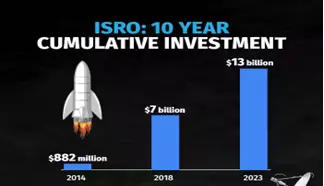
Benefits of ISRO’s Space Programmes and Investments
- Employment Generation: ISRO directly employs scientists, engineers, and technicians, and indirectly supports jobs in satellite manufacturing and data analysis.
- Economic Benefits:
- Investments in ISRO's space missions yield returns of about 2.54 times the expenditure.
- Between 2014 and 2024, the Indian space sector generated USD 60 billion, created 4.7 million jobs, and contributed USD 24 billion in tax revenues.
- Agricultural Development: ISRO’s Earth Observation Satellites, like Resourcesat and Cartosat, aid in monitoring crop health, soil moisture, and land use, improving agricultural productivity.
- Disaster Management and Resource Planning:
- Satellites provide data for disaster response and resource monitoring, supporting sustainable management and agricultural planning.
- ISRO's weather forecasts benefit around 8 lakh fisherfolk and 1.4 billion people.
- Urban Planning and Infrastructure Development: High-resolution satellite imagery assists in urban mapping, traffic management, and infrastructure monitoring, optimising land use and improving public services.
- Inspiring Youth and Education: Achievements like Chandrayaan and Mangalyaan inspire students and promote careers in STEM fields, stimulating interest in science and technology.
- Lunar Exploration and Scientific Advancement: Chandrayaan missions advance lunar exploration, demonstrate India’s space capabilities, and contribute to global space science.
- International Collaboration and Soft Power:
- ISRO’s success in launching foreign satellites enhances India's global reputation and fosters international collaborations.
- Its cost-effective approach attracts global partnerships and stimulates innovation in space-related startups.
Current Position in the Space Sector:
- Space Economy: As of 2024, India’s space economy is valued at Rs 6,700 crore (USD 8.4 billion), contributing 2%-3% of the global space economy, projected to reach USD 13 billion by 2025 with a 6% CAGR.
- Gross Value Added: From 2014 to 2023, the space sector added USD 60 billion to the gross value. This is expected to rise to USD 89 billion to USD 131 billion in the next decade.
- Global Ranking: ISRO is the sixth-largest space agency globally, with a high success rate in launch missions, alongside NASA, CNSA, ESA, JAXA, and Roscosmos.
- Private Sector Growth: India has over 400 private space companies, with startups increasing from 54 in 2020 to over 200, following the establishment of IN-SPACe.
Indian Space Policy 2023
- Transition of ISRO’s Role:
- ISRO's goal is to increase India's share in the global space economy from 2% to 10% by 2034, transitioning from routine tasks to leadership in space infrastructure, transportation, applications, and human spaceflight.
- InSPACe (Indian National Space Promotion and Authorisation Centre):
- Functions as a single-window agency for authorising space activities and fostering industry-academia collaboration.
- New Space India Limited (NSIL):
- Responsible for commercialising space technologies, manufacturing and leasing space components, and servicing space needs on commercial principles.
- Department of Space:
- Implements the policy, ensures safe space operations, and manages international cooperation.
- Private Participation Encouragement:
- Non-governmental entities are permitted to engage in all aspects of space activities, including satellite operations, rocket development, spaceport construction, and providing services like communication, remote sensing, and navigation, both domestically and internationally.
Major Developments in the Space Sector in India
- Recent Major Successful Missions:
- Aditya L1
- Chandrayaan 3
- Mars Orbiter Mission (Mangalyaan)
- Advancements in Launch Vehicles:
- GSLV Mark III
- Small Satellite Launch Vehicle (SSLV)
- PSLV
- Missions for International Clients:
- TeLEOS-2 (2023): Singaporean Earth observation satellite
- PSLV-C51 (2021): Launched Brazil's Amazonia-1 satellite and 18 smaller satellites.
- Other Key Developments:
- NavIC
- Bhuvan
Increasing India’s Share in the Space Sector:
- Skill Development:
- Invest in space-related education and training programs to cultivate a highly skilled workforce.
- Establish Space Technology Incubation Centres to nurture talent and advance research.
- Infrastructure Development:
- Upgrade space launch facilities and research centres to support ambitious space missions.
- Develop the Virtual Launch Control Center (VLCC) at the Vikram Sarabhai Space Centre to enhance operational capabilities.
- Government-Industry Collaboration:
- Strengthen partnerships between government agencies and private enterprises to combine strengths and accelerate space exploration and technology advancements.
- Promotion of Indigenous Technologies:
- Encourage the development of homegrown technologies to foster self-reliance.
- Invest in indigenous research and manufacturing to design and produce advanced space technologies.
|
UPSC Civil Services Examination, Previous Year Questions (PYQs) Prelims Q:1 Consider the following statements: (2016)
Which of the statements given above is/are correct?
Ans: (c)
Mains Q:1 What is India’s plan to have its own space station and how will it benefit our space programme? (2019) Q:2 Discuss India’s achievements in the field of Space Science and Technology. How the application of this technology helped India in its socio-economic development? (2016) |
Unified Pension Scheme
Why in the news?
- The Union Cabinet has recently approved the Unified Pension Scheme (UPS) for Central government employees, offering an assured pension of 50% of the average salary drawn over the last 12 months of service.
- This scheme mirrors the Old Pension Scheme (OPS) and will be optional for existing employees under the National Pension System (NPS).

- Old Pension Scheme (OPS):
- About: OPS provided government employees with a pension based on their last drawn salary, specifically 50% of the last drawn amount.
- Defined Benefit: It was a ‘Defined Benefit Scheme’, guaranteeing a fixed pension, with increases linked to dearness allowance (DA).
- Concerns: The pension liability under OPS was unfunded, leading to budgetary strain and inter-generational equity issues. The scheme was discontinued in 2003 due to these fiscal concerns.
- National Pension System (NPS):
- Introduction: NPS was introduced in April 2004 as a replacement for OPS. It is open to public, private, and unorganised sector employees, except armed forces.
- Investment-Oriented: NPS encourages regular investment during employment, with post-retirement benefits including a monthly pension from the remaining corpus after a partial withdrawal.
- Market-Linked Returns: Unlike OPS, NPS does not guarantee fixed returns as it is subject to market volatility.
- Difference between NPS and OPS:
- OPS: Guarantees a fixed pension amount, irrespective of market conditions.
- NPS: An investment-based scheme with variable returns depending on market performance. Contributions are defined, but benefits vary.
Unified Pension Scheme (UPS):
- About: The UPS reverses a 21-year-old pension reform, offering an assured pension similar to OPS.
- Key Features:
- Assured Pension:
- Employees with a minimum of 25 years of service will receive an assured pension of 50% of their average basic pay over the last 12 months before retirement.
- Those with less than 25 years of service will receive a proportionate pension, with a minimum qualifying service period of 10 years.
- Assured Family Pension: In case of an employee's demise, their spouse will receive a family pension, assured at 60% of the pension the employee was drawing before their death.
- Assured Minimum Pension: Employees with at least 10 years of service are guaranteed a minimum pension of ₹10,000 per month upon retirement.
- Inflation Indexation: Both the assured pension and the family pension will be adjusted for inflation, ensuring that pensions keep pace with rising costs.
- Dearness Relief: Retirees under the UPS will receive Dearness Relief based on the All-India Consumer Price Index for Industrial Workers (AICPI-IW), similar to serving employees.
- Lump Sum Payment on Superannuation:
- Upon retirement, employees will receive a lump sum payment equivalent to 1/10th of their monthly emoluments (including pay and Dearness Allowance) for every completed six months of service, in addition to gratuity.
- This payment does not reduce the quantum of the assured pension.
- Assured Pension:
Source: NDTV
ISRO’s Chandrayaan-4 Mission
Why in the news?
- The designs for India's upcoming lunar mission, Chandrayaan-4, have been finalised, with the mission likely to take place in 2027, as announced by ISRO Chairman S. Somanath on National Space Day.
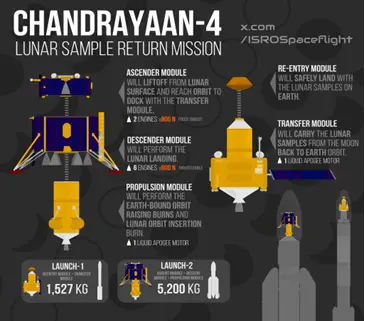
About Chandrayaan-4 Mission:
- Objective:
- Chandrayaan-4 is a lunar sample-return mission, aiming to achieve a soft landing on the Moon, collect lunar rock samples, and return them to Earth.
- If successful, India will join the ranks of the U.S., Russia, and China in accomplishing this challenging feat.
- Key Objectives of the Mission:
- Achieving a safe and gentle landing on the lunar surface.
- Collecting and storing lunar samples.
- Lifting off from the Moon's surface.
- Docking and undocking in lunar orbit.
- Transferring samples between spacecraft modules.
- Returning the collected samples safely to Earth.
- Mission Strategy and Components:
- Propulsion System: Transports the lander and ascender stages to the Moon.
- Descender: Designed for the lunar landing, carrying equipment for soil sampling.
- Ascender: Detaches from the lander after collecting samples and lifts off from the lunar surface.
- Transfer Module: Receives samples from the Ascender and transports them to the Re-entry module.
- Re-entry Module: Safely brings the lunar samples back to Earth, designed to withstand re-entry into Earth's atmosphere.
- About Payloads:
- Lunar Propulsion Module: Similar to the propulsion module used in Chandrayaan-3, it transports the Lunar Lander and Ascender stages to the Moon.
- Lunar Lander: Touches down on the Moon, carrying instruments to support the Ascender stage and soil sampling equipment.
- Lunar Module Ascender: After collecting samples, it detaches from the Lander, ascends to lunar orbit, and prepares for docking.
- Transfer Module: Transfers the samples from the Ascender to the Re-entry Module, propelling them back to Earth.
- Re-entry Module: Safely returns to Earth with the lunar samples.
- Dual Rocket Launch Strategy:
- Chandrayaan-4 will utilise two different rockets:
- Launch Vehicle Mark-3 (LMV-3): Carries the propulsion, descender, and ascender modules.
- Polar Satellite Launch Vehicle (PSLV): Transports the transfer and re-entry modules to their designated lunar orbits.
- The rockets will be launched on different dates, with the earliest launch expected around 2028.
- Chandrayaan-4 will utilise two different rockets:
- Advanced Technology and Space Docking Experiment (SPADEX):
- The mission's success hinges on the successful docking of the Ascender Module with the Transfer Module in lunar orbit, relying on the completion of the Space Docking Experiment (SPADEX).
- This experiment, developed by ISRO, involves two spacecraft and advanced technologies for orbital rendezvous, docking, and formation flying, crucial for the Chandrayaan-4 mission.
- Chandrayaan-4, likely to occur in 2027, will be more complex than its predecessor, involving five separate modules and requiring two space docking operations—a first for ISRO.
- Two key capabilities for this mission were successfully tested during Chandrayaan-3.
- Final government approval is awaited, and ISRO has also completed the design for Chandrayaan-5, though its objectives and timeline are yet to be disclosed.
Key Challenges in the Indian Space Programme:
- Limited Budget Allocation:
- India’s space budget is a modest 0.05% of GDP, compared to the U.S.'s 0.25%, limiting the scope of ambitious space missions.
- Technological Challenges:
- India is ranked 7th globally in satellite operations and relies on Western technology for key components.
- The human spaceflight program also faces hurdles in astronaut training and life support systems.
- Commercialization and Market Access:
- With only 2.6% of the global space economy, India has limited involvement in space manufacturing, human space transport, and space tourism.
- There is also a need for better support for space start-ups and increased investor interest.
- Space Policy and Legislation:
- The delay in developing comprehensive space policies and legislation is hampering progress.
- The Indian Space Policy, 2023 lacks a specific timeline for implementing InSPACe’s ambitious goals.
- Space Debris Management:
- Effective management of space debris is becoming increasingly important with the rise in space activities.
- India needs strategies to minimise debris and engage in international debris mitigation efforts.
- Geopolitical Realignment:
- India’s participation in the Artemis Accords is a strategic move amid evolving geopolitical dynamics and aims to balance relations with China.
Way Forward for India's Space Domain:
- Substantial Investment:
- Shift from frugal engineering to significant investments in ambitious projects and enhance budget allocations for expansive space missions.
- Expertise in Human Spaceflight:
- Focus on developing human spaceflight capabilities, including astronaut training and necessary infrastructure for crewed missions.
- Private Sector Participation:
- Foster private sector involvement, aligning with global trends where commercial entities play a major role in space exploration.
- Geopolitical Negotiations:
- Navigate international collaborations and rivalries strategically, particularly concerning relations with China, to ensure beneficial agreements.
- Legal Framework:
- Develop comprehensive national and international legal frameworks to regulate and promote space activities, including reforms for global governance.
- International Collaboration:
- Strengthen international partnerships and collaborative efforts to ensure space remains a cooperative domain for all nations.
|
UPSC Civil Services Examination, Previous Year Question (PYQ) Prelims Q:1 Consider the following statements: (2016)
Which of the statements given above is/are correct?
Ans: (c)
Mains Q:1 What is India’s plan to have its own space station and how will it benefit our space programme? (2019) |
Source: IE
Prime Minister’s Visit to Ukraine
Bilateral relation- Regional and Global Groupings
Why in the news?
- Recently, Prime Minister Narendra Modi's visit to Ukraine marks the first visit by an Indian Prime Minister since Ukraine’s independence in 1991.
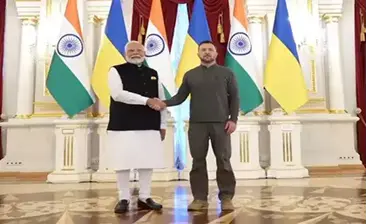
Key Developments:
- Agreements Signed:
- Humanitarian Assistance: High-capacity development projects.
- Agriculture and Food Industry: Cooperation agreements.
- Cultural Cooperation: Enhancing cultural ties.
- Drug Quality and Regulation: Agreement on standards and regulations.
- Strategic Position: Modi's visit to Russia in July followed by this visit to Ukraine positions India uniquely in facilitating dialogue between the leaders of Russia and Ukraine.
- India’s Position on the Russia-Ukraine War
- Neutral Stance: India distanced itself from the US-led sanctions on Russia while expressing concern over civilian casualties.
- Call for Dialogue: Advocates for direct talks between Russia and Ukraine, emphasising that "this is not the era of war."
- Significance of the Visit
- Historical Importance: First visit by an Indian Prime Minister to Ukraine post-independence, signalling a commitment to enhance bilateral relations.
- Diplomatic Balancing Act: India showcases its role as a mediator between Russia and the West, enhancing its diplomatic leverage.
- Influence on Global South: India's engagement aims to sway global opinion in the Global South, which remains economically impacted by the conflict.
- Active Role: Reflects India’s intent to be a proactive player in global geopolitical dynamics.
- India-Ukraine Relations
- Diplomatic Relations: Established in 1992 after India recognized Ukraine's sovereignty in 1991.
- Trade Growth: Bilateral trade reached $3.386 billion in 2021-22.
- Humanitarian Assistance: Extended aid in response to the humanitarian crisis caused by the conflict.
- Support in International Forums: India has supported Ukraine's sovereignty and received appreciation for its balanced approach.
- Challenges and Tensions
- Recent Moscow Visit: Modi’s previous visit to Russia has been criticised by Ukraine, potentially affecting perceptions of India's impartiality.
- Neutrality vs. Support: India's neutral stance and reluctance to condemn Russia explicitly might impact its credibility and influence on international matters.
Conclusion
Modi’s visits reflect India’s strategy to balance relations with both Russia and Ukraine while maintaining its independent position on the conflict. These visits are likely to shape India’s diplomatic strategies and its role in global peace and stability efforts.
Source: TH
Vigyan Dhara Scheme
Why in the news?
- Recently, The Union Cabinet approved the continuation of three umbrella schemes, merging them into a unified central sector scheme called “Vigyan Dhara” under the Department of Science and Technology (DST).

About Vigyan Dhara Scheme:
- Unified Central Sector Scheme:
- Vigyan Dhara consolidates three major schemes from the Department of Science and Technology (DST) into one central sector scheme.
- The scheme is organised into three core components:
- Science and Technology (S&T) Institutional and Human Capacity Building.
- Research and Development (R&D).
- Innovation, Technology Development, and Deployment.
- Objective:
- The primary goal of Vigyan Dhara is to promote S&T capacity building, research, innovation, and technology development, thereby strengthening the Science, Technology, and Innovation ecosystem in India.
- Budget and Implementation:
- The proposed outlay for the scheme is ₹10,579.84 crore during the 15th Finance Commission period (2021-22 to 2025-26).
- The merger aims to improve efficiency in fund utilisation and synchronisation among sub-schemes/programs.
- Components:
- Research Focus: The scheme supports research in areas such as basic research with access to international mega facilities, sustainable energy, and water, and fosters international cooperation through bilateral and multilateral collaborations.
- Human Resource Development: It aims to build a critical human resource pool to enhance the S&T landscape, increasing the Full-Time Equivalent (FTE) researcher count.
- Gender Parity in S&T: Focused interventions will enhance women's participation in S&T, aiming for gender parity in Science, Technology, and Innovation (STI).
- Alignment with National Goals: All programs under Vigyan Dhara align with DST's 5-year goals, contributing to the vision of Viksit Bharat 2047. The R&D component is aligned with the Anusandhan National Research Foundation (ANRF).
Source: IE
BioE3 (Biotechnology for Economy, Environment
Why in the news?
- Recently, The Union Cabinet approved the 'BioE3' Policy, aimed at enhancing high-performance biomanufacturing under the Department of Biotechnology.

About BioE3 Policy:
- Objective:
- The BioE3 Policy is designed to foster high-performance biomanufacturing, enabling the production of diverse products from medicine to materials, while addressing challenges in farming, food security, and the development of bio-based products.
- High-Performance Biomanufacturing:
- The policy emphasises advanced biotechnological processes to enhance the efficiency of biomanufacturing, integrating innovation-driven support for research, development, and entrepreneurship across various thematic sectors.
- Strategic Initiatives:
- The policy will accelerate technology development and commercialization by establishing biomanufacturing hubs, bio-AI hubs, and biofoundries.
- It prioritises regenerative bioeconomy models, promoting green growth and sustainable development.
- Employment and Skill Development:
- A significant focus of the policy is on expanding India’s skilled workforce, facilitating job creation in biotechnology sectors through targeted training and capacity-building initiatives.
- Focus Areas:
- The BioE3 Policy will address national priorities by focusing on the following strategic sectors:
- High-value bio-based chemicals.
- Biopolymers and enzymes.
- Smart proteins and functional foods.
- Precision biotherapeutics.
- Climate-resilient agriculture.
- Carbon capture and utilisation.
- Marine and space research.
- The BioE3 Policy will address national priorities by focusing on the following strategic sectors:
Source: PIB
GS-3, Science & Technology- Biotechnology
Why in the news?
- Recently, The Union Cabinet approved the 'BioE3' Policy, aimed at enhancing high-performance biomanufacturing under the Department of Biotechnology.
About BioE3 Policy:
- Objective:
- The BioE3 Policy is designed to foster high-performance biomanufacturing, enabling the production of diverse products from medicine to materials, while addressing challenges in farming, food security, and the development of bio-based products.
- High-Performance Biomanufacturing:
- The policy emphasises advanced biotechnological processes to enhance the efficiency of biomanufacturing, integrating innovation-driven support for research, development, and entrepreneurship across various thematic sectors.
- Strategic Initiatives:
- The policy will accelerate technology development and commercialization by establishing biomanufacturing hubs, bio-AI hubs, and biofoundries.
- It prioritises regenerative bioeconomy models, promoting green growth and sustainable development.
- Employment and Skill Development:
- A significant focus of the policy is on expanding India’s skilled workforce, facilitating job creation in biotechnology sectors through targeted training and capacity-building initiatives.
- Focus Areas:
- The BioE3 Policy will address national priorities by focusing on the following strategic sectors:
- High-value bio-based chemicals.
- Biopolymers and enzymes.
- Smart proteins and functional foods.
- Precision biotherapeutics.
- Climate-resilient agriculture.
- Carbon capture and utilisation.
- Marine and space research.
- The BioE3 Policy will address national priorities by focusing on the following strategic sectors:
Source: PIB
Sonobuoys
Why in the news?
- Recently, The United States approved a government-to-government deal worth USD 52.8 million for the sale of Anti-Submarine Warfare (ASW) Sonobuoys, to be integrated with the Indian Navy’s Romeo helicopters.

About Sonobuoys:
- About:
- Sonobuoys are small, expendable devices used in underwater acoustics and sonar systems to detect and analyse sound in the ocean, primarily for tracking submarines and other underwater objects.
- They are a core technology in anti-submarine warfare, aiding in the detection and tracking of potentially hostile submarines in both open oceans and coastal areas.
- Historical Use:
- Sonobuoys were first utilised during World War II for detecting German U-boats, playing a crucial role in naval warfare.
- Deployment:
- Sonobuoys are deployed by dropping them from aircraft or launching them from ships or submarines.
- Upon deployment, they sink to a predetermined depth and begin listening for acoustic signals, assisting in the identification of potential submarine threats.
- Multiple sonobuoys can be deployed in a strategic pattern to accurately determine the location of a target.
- Types:
- Passive Sonobuoys: These devices quietly listen for and record sounds without emitting any signals, using a hydrophone to detect sound energy from a target.
- Active Sonobuoys: These devices emit a sound pulse and analyse the return signals (echoes) to detect and locate targets, utilising a transducer to send acoustic signals.
- Special Purpose Buoys: These provide environmental data such as water temperature and ambient noise levels, crucial for both military and scientific applications.
- Components:
- A typical sonobuoy includes a buoyant housing, sensors for detecting acoustic signals, a power source (battery), and a communication system (radio transmitter) to relay data to the host platform (e.g., aircraft or ship).
- Other Applications:
- Beyond anti-submarine warfare, sonobuoys are used in scientific research and environmental studies, including monitoring marine life behaviour, such as that of whales.
Source: TP
Virupaksha Temple
- The Virupaksha Temple in Hampi, Karnataka, has recently been in the spotlight due to concerns over conservation efforts following the collapse of a temple pavilion, the saalu mantapa, during heavy rains in 2024.

Historical Significance:
- Dedication:
- The temple is dedicated to Lord Virupaksha, a manifestation of Lord Shiva.
- Location:
- Situated in Hampi, within the Vijayanagara district of Karnataka, the temple is part of the larger Group of Monuments at Hampi, a UNESCO World Heritage Site since 1986.
- Inception:
- The temple has been in continuous operation since the 7th century AD, making it one of India's oldest functioning temples.
- Development:
- Originally a modest shrine, the temple was expanded during the reign of the Vijayanagara kings, with contributions from the Chalukyan and Hoysala eras, achieving its current grandeur.
Architectural Features:
- Style:
- The temple is built in the South Indian architectural style, showcasing intricate craftsmanship and advanced engineering techniques.
- Main Structure:
- The complex includes a sanctum sanctorum, multiple pillared halls, antechambers, and grand gopurams (gateway towers), with the most elaborate being a hall with 100 pillars.
- Gopurams:
- The temple has three prominent gopurams, with the eastern gopuram being the largest, standing nine stories tall and 50 meters high. The other two are smaller gopurams located on the inner east and inner northern sides.
- Sculptural Details:
- The gopurams are adorned with intricate sculptures of various Hindu deities.
- Innovative Construction:
- The temple's design incorporates principles of physics, such as the Rectilinear Light Theory and the pinhole camera effect.
- It also utilises mathematical concepts like fractals, geometry, complex mathematics, and the Fibonacci sequence.
- Notably, the temple features an inverted pinhole image of its tower on the inner wall, showcasing ancient engineering prowess.
Cultural Importance:
- Religious and Cultural Hub:
- The Virupaksha Temple remains a focal point of religious and cultural activities in Hampi, attracting both pilgrims and tourists.
- Uninterrupted Worship:
- Its continuous history of worship highlights its enduring significance in India's spiritual landscape.
Source: IE
The road to 2047 for Indian agriculture
Context:
- India’s centennial year of independence is still away, in 2047, but the goal of becoming a developed nation looms large.
- India’s 100th independence anniversary in 2047 is approaching, and the goal to become ‘a developed nation’ in the agriculture sector.

Goals of Indian Agriculture by Vision 2047:
- Comprehensive Goal:
- As India approaches its centennial year of independence, the Vision 2047 underscores the need for a six-fold increase in per capita Gross National Income (GNI), with a focus on comprehensive development, particularly in the agricultural sector.
- Trade Goal:
- In 2022-23, India’s agricultural and processed food exports surpassed USD 50 billion.
- Vision 2047 aims to enhance the availability of nutritious foods by improving fruit and vegetable processing and increasing the share of value-added products in India’s export portfolio.
- Sustainable Goal:
- The transformation of Indian agriculture is contingent on the adoption of sustainable practices, including precision farming, genetically modified crops, and advanced irrigation techniques like drip and sprinkler systems.
Significance of Agriculture in India:
- Contribution to GDP:
- Agriculture's share in India's GDP has declined from 35% in 1990-91 to 15% in 2022-23, reflecting the rapid growth of the industrial and service sectors, though it remains a crucial sector.
- Employment:
- Agriculture is the largest employer, with approximately 45.76% of the workforce engaged in the sector as of 2022-23, according to the PLFS.
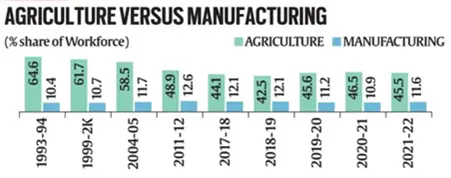
- Food Security:
- India is self-sufficient in staple foods like rice and wheat and leads in the global production of milk, pulses, and spices. The Public Distribution System (PDS) ensures food security for the population.
- Land Use:
- Over 50% of India’s geographical area is used for agriculture, with 195 million hectares under cultivation, 63% of which is rainfed and 37% irrigated.
- Foreign Exchange:
- Agricultural exports are vital for foreign exchange, contributing USD 52.50 billion in 2022-23, with products like rice, spices, and cotton leading the way.
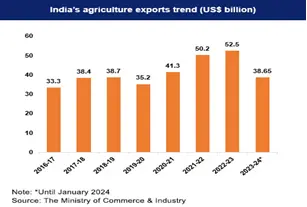
- Socio-Cultural and Environmental Sustainability:
- Agriculture is central to India’s cultural heritage, influencing rural traditions and community life. Sustainable practices are essential for preserving soil, water, and biodiversity, ensuring long-term environmental sustainability.
Present Imbalance in the Indian Economy:
- Workforce vs. GDP Contribution:
- Although agriculture employs nearly 46% of India’s workforce, it contributes only about 18% to the GDP, highlighting a significant economic imbalance.
- Growth Disparity:
- Since 1991-92, while the overall GDP has grown at an annual rate of 6.1%, agricultural GDP has lagged behind at 3.3%.
- In the last decade (2013-2023), the overall GDP growth rate was 5.9%, with agriculture growing at 3.6%, underscoring the sector’s socio-economic challenges.
- Future Projections:
- By 2047, agriculture’s share in GDP may decline to 7%-8%, but it could still employ over 30% of the workforce.
- This scenario necessitates substantial structural changes to prevent further exacerbation of the existing economic disparity.
Government Initiatives:
- For Water Management: The Pradhan Mantri Krishi Sinchayee Yojana (PMKSY) has promoted water-use efficiency through micro-irrigation, covering 78 lakh hectares with a ₹93,068 crore allocation for 2021-26.
- For Risk Management: The Pradhan Mantri Fasal Bima Yojana (PMFBY) provides financial assistance for crop losses, with 49.5 crore farmers enrolled and claims exceeding ₹1.45 lakh crore.
- For Market Access: The Electronic National Agriculture Market (eNAM) integrates existing markets via an electronic platform, benefiting 1.76 million farmers and recording trade worth ₹2.88 lakh crore by September 2023.
- For Better Farmer Support: The Pradhan Mantri Kisan Samman Nidhi (PM-KISAN) scheme, which disburses ₹6,000 annually to farmers, has benefited over 11.8 crore farmers.
- For Enhanced Soil Health: The Soil Health Card (SHC) scheme aims to optimise soil nutrient use and improve productivity, with over 23 crore SHCs distributed.
Need for Strategic Planning:
- Population Growth: India’s population is projected to reach 1.5 billion by 2030 and 1.59 billion by 2040, increasing food demand by approximately 2.85% annually.
- Future Demand: By 2047-48, food grain demand is projected to range between 402 million tonnes and 437 million tonnes, necessitating sustainable production that exceeds demand by 10%-13% under a Business-As-Usual scenario.
Key Challenges Related to the Farm Sector in India:
- Small Land Holdings:
- A significant portion of arable land is divided into small holdings, limiting economies of scale.
- As per the Agriculture Census 2015-16, 86.1% of Indian farmers are small and marginal, with landholdings smaller than 2 hectares.
- Economic Hardships:
- The average monthly income of a farmer's household was approximately ₹10,218 as per the NSO report (2019), highlighting economic challenges.
- Over 50% of agricultural households were in debt, according to the 2019 NSS survey.
- Soil Degradation & Water Scarcity:
- Around 90% of India's groundwater is used for agriculture, leading to depleting aquifers.
- Soil degradation due to improper practices reduces fertility and productivity.
- Inadequate Agricultural Infrastructure:
- Insufficient storage and cold chain facilities, inadequate rural roads, and limited market access result in post-harvest losses and higher production costs.
- Underinvestment in Agricultural Research:
- Investment in agricultural research has not kept pace with inflation, resulting in decreased real funding and hindering innovation.
- Outdated Farming Practices:
- A significant portion of farmers rely on traditional methods, with limited access to modern techniques and information, slowing the adoption of advanced practices.
- Market Volatility & Price Fluctuations:
- Farmers face price volatility due to weak market linkages and global pressures, leading to uncertain returns.
- Policy challenges, including the impact of WTO rulings, contribute to depressed farm-gate prices.
- Skewed Policy Challenges:
- The public distribution system provides cereals at low prices, driving down the income farmers earn from their crops.
- Skewed fertiliser subsidies promote overuse, affecting human health and environmental sustainability.
- Climate Change & Natural Disasters:
- Unpredictable weather, climate change, and natural disasters like floods and droughts pose significant challenges.
- Without adaptation measures, rainfed rice yields in India could decrease by 20% by 2050 and 47% by 2080, according to climate change impact assessments.
Way Forward:
- Investment in R&D:
- R&D Funding: Significant investments in agricultural R&D are vital to foster innovation, enhance crop resilience, and ensure food security.
- Infrastructure Development: Developing robust agricultural infrastructure will reduce post-harvest losses and improve supply chain efficiency.
- Strategic Budget Allocation:
- Agricultural Credit: The 2024-25 budget allocates ₹20 lakh crore for agricultural credit and introduces the Agriculture Accelerator Fund to drive innovation.
- Support for Small Farmers: Prioritise budget support for small and marginal farmers to enhance access to credit, subsidies, and modern inputs.
- Enhance Digital Infrastructure:
- Digital Platforms: Expand platforms like eNAM to improve market access, real-time data availability, and price realisation for farmers.
- Digital Literacy: Promote digital literacy among farmers to ensure they can fully utilise digital tools and participate in the digital agricultural ecosystem.
- Holistic Agricultural Approach:
- Integrate production, marketing, and consumption in agriculture.
- Enhance access to credit, inputs, and farmer advisory services.
- Promote sustainable farming practices and strengthen FPOs and cooperatives.
- Value Chain Development:
- Build value chains for high-value crops, dairy, fisheries, and poultry.
- Implement public-private partnerships and schemes like PLI to boost value chain development.
Conclusion:
India's Vision 2047 for agriculture demands strategic investments in R&D, infrastructure, and digital platforms, alongside targeted budget allocations to support farmers. By focusing on innovation, resilience, and efficiency, India can ensure sustainable agricultural growth, improve farmers' livelihoods, and secure food security, positioning itself as a global leader in agriculture by its centennial year of independence.
|
UPSC Civil Services Examination, Previous Year Question (PYQ) Prelims: Q:1 In the context of India’s preparation for Climate -Smart Agriculture, consider the following statements: (2021)
Which of the statements given above are correct?
Ans: (d) Q:2 Consider the following pairs: (2014) Programme/Project Ministry
Which of the above pairs is/are correctly matched?
Ans: (d)
Q:3 In India, which of the following can be considered as public investment in agriculture? (2020)
Select the correct answer using the code given below:
Ans: (c)
Mains: Q:1 Given the vulnerability of Indian agriculture to vagaries of nature, discuss the need for crop insurance and bring out the salient features of the Pradhan Mantri Fasal Bima Yojana (PMFBY). (2016) Q:2 Explain various types of revolutions, took place in Agriculture after Independence in India. How have these revolutions helped in poverty alleviation and food security in India? (2017) |
Source: TH
Share the article
Edukemy’s Current Affairs Quiz is published with multiple choice questions for UPSC exams
MCQ
Get Latest Updates on Offers, Event dates, and free Mentorship sessions.

Get in touch with our Expert Academic Counsellors 👋
FAQs
UPSC Daily Current Affairs focuses on learning current events on a daily basis. An aspirant needs to study regular and updated information about current events, news, and relevant topics that are important for UPSC aspirants. It covers national and international affairs, government policies, socio-economic issues, science and technology advancements, and more.
UPSC Daily Current Affairs provides aspirants with a concise and comprehensive overview of the latest happenings and developments across various fields. It helps aspirants stay updated with current affairs and provides them with valuable insights and analysis, which are essential for answering questions in the UPSC examinations. It enhances their knowledge, analytical skills, and ability to connect current affairs with the UPSC syllabus.
UPSC Daily Current Affairs covers a wide range of topics, including politics, economics, science and technology, environment, social issues, governance, international relations, and more. It offers news summaries, in-depth analyses, editorials, opinion pieces, and relevant study materials. It also provides practice questions and quizzes to help aspirants test their understanding of current affairs.
Edukemy's UPSC Daily Current Affairs can be accessed through:
- UPSC Daily Current Affairs can be accessed through Current Affairs tab at the top of the Main Page of Edukemy.
- Edukemy Mobile app: The Daily Current Affairs can also be access through Edukemy Mobile App.
- Social media: Follow Edukemy’s official social media accounts or pages that provide UPSC Daily Current Affairs updates, including Facebook, Twitter, or Telegram channels.

